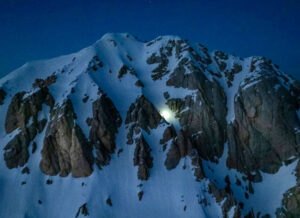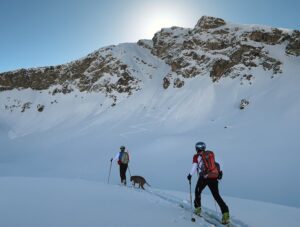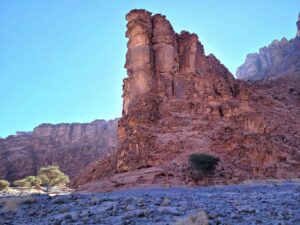Edward “Ned” Gillette changed the game. Professional adventurers and mountaineers weren’t new, but they were often reluctant celebrities, ill-at-ease with the media spotlight. Gillette could never be described as ill-at-ease. Eloquent, brimming with confidence and possessing a silver-tongued salesman’s patter, he seemed almost custom-built for a new age of media.
Though Gillette wasn’t born into adventure, he had a head start. Born in the small town of Barre, in Vermont’s Green Mountains, he learned to ski by age three. He was coached by his father, an already retired former insurance company president. By five, he was hurtling down nearby Mount Mansfield. In high school, he chose a specific discipline: cross-country skiing. It proved a good choice. He went on to attend the Ivy League college of Dartmouth, where he became the 1967 NCAA cross-country ski champion and team captain. The next year, he represented the United States at the Olympics (though as a non-competing substitute).
Shortly afterwards, his life fleetingly took a more conventional turn. A career in cross-country skiing didn’t seem prudent, so he enrolled in a Colorado business school. He lasted just one day. In an ominous precursor to every travel influencer and adventurer-turned-motivational-speaker, he proudly included the sudden change of direction on his resume.

Gillette’s first passion was skiing. Photo: Galen Rowell
Free from a set career path, Gillette headed for Yosemite and quickly fell in with the climbing crowd. But the drive of his upbringing, “which meant bullying forward,” according to an account of Gillette’s life by Todd Balf in Men’s Journal, had not disappeared. Early Gillette adventures included a 500km ski traverse of the Brooks Range and his 1978 circumnavigation of Denali, the first in 70 years.
Only two weeks after the circumnavigation, he catapulted himself into the national spotlight with a crazy, single-day climb of Denali with photographer Galen Rowell. Climbing Denali in 19 hours was outlandish, dangerous and quite brilliant. Even as his adventure resume ballooned, it remained “the craziest thing I have ever done,” according to the man himself.
Crazy worked. Gillette found himself well-positioned to fashion a new life as an adventure celebrity, with skills well-suited to the emerging game of expedition salesmanship. Outside described his “enviable knack for conjuring trips in his mind and brewing up an elusive alchemy of sponsorship, grants, and publicity to make it all happen.”
After Denali, more trips were conjured up and monetized. First, it was over to New Zealand for a midwinter traverse of the southern Alps sponsored by National Geographic. Each member of the team (Gillette, Jan Reynolds, Allan Bard and Tom Carter) were required to shoot 100 rolls of film as part of a sponsorship deal that would never exist in 2020. The 200km trip, estimated to take 10 days, eventually took a month, including a brutal seven-day stint in a snow cave.

Expedition mate Allan Bard in New Zealand’s Valley of Death during their 1979 traverse. Photo: Tom Carter
Without pausing to catch his breath, it was on to China for the first climb and ski descent of the 7,546m Muztagh Ata. Gillette and his party were the first Americans allowed to climb in China since World War II, and they made the most of their opportunity. Their ski descent was the first-ever of any mountain above 7,500m. They descended some 1,500m at night, in perfect powder: “It was like skiing into the bowels of the earth,” Gillette told People in 1980. “It was the greatest ski run I’ve ever had in my life.”
In 1981, Gillette took on Everest. But, ever the showman, he put a new spin on the expedition. “We live in a time where you can no longer climb the highest peak, or no longer explore blank spots on a map. Adventure is looking at old subjects in a new way,” he explained. Instead of summiting, Gillette’s team attempted a 500km Everest circumnavigation. The trip took 120 days of skiing, climbing and hiking but received its fair share of criticism. Gillette’s silver tongue had won sponsorship from an unlikely source, Camel cigarettes. Though not a smoker himself, Gillette was not one to look a gift horse in the mouth. He took the sponsorship money, even pausing between the two segments of his Everest expedition to fly back to Las Vegas for a corporate trade show.

Gillette (left) enjoying a beer in the mountains. Photo: Allan Bard
Though contemporaries were sometimes critical of the change to sponsored expeditions and corporate interests, Gillette remained popular, both with legions of casual fans and the purists. The old guard begrudgingly admitted that Gillette maintained his integrity while selling both himself and the outdoor industry, in a way that was unimaginable only a few years before.
Mass media had changed everything. Gillette recognized how to harness this power before most, thanks to his unique blend of talents. The New York Times summed it up nicely: “The North Face didn’t invent the idea of the quotable, amicable, eloquent jock who also happened to be in the one-tenth-of-one-percent who could climb, ski, and suffer like nobody else: Ned Gillette showed the outdoor industry how to market itself.”
Gillette needed all his marketing wiles to get his next expedition off the ground: a daring row of the Drake Passage between Chile and Antarctica. Despite what Colin O’Brady would have you believe, this was the first row of the notoriously stormy passage. Somehow, despite the apparent lunacy of the concept, Gillette secured $110,000 in cash and $60,000 worth of equipment from sponsors. He also made key connections in the Chilean Navy, Air Force and Hydrographic Office. Despite a turbulent start that he described as “like a Nantucket sleigh ride. It was so exciting, we were all getting seasick,” the two-week crossing was a success.

Gillette celebrates getting their rowboat, christened the “Sea Tomato”, into the water in Chile. Photo: Eva Schandl
After the Drake Passage, more adventures followed, most of them with wife Suzy Patterson, a former U.S. Olympic downhill skier. They crisscrossed the globe, skiing, climbing and hiking, selling photos as they went. In an interview with Backpacker in 1982, Gillette had described his expedition mentality as: “Doing things in a new style. For me, that means climbing and skiing faster, on harder terrain, in more severe conditions with smaller teams.” He had even described his expeditions as “long periods of nastiness and boredom, interspersed with a few moments of glory.” But now, he seemed to have almost settled down. The trips were less extreme, if no less unique. In 1993, they rode 10,000km on camels from China to the Mediterranean, following the old Silk Road through Central Asia.
Like many pioneering adventurers, Gillette’s death came far too early. Gillette viewed the crux of successful adventuring as the careful calculation of risk, and it was not a mistake that cost him his life. Instead, he was murdered in a cowardly attack. While asleep high in the Karakorum, Gillette was shot while inside his tent in what appears to have been a robbery gone wrong. Patterson, trying to save her husband’s life, was also hit by a shotgun blast but miraculously survived. The adventure community was shell-shocked: “When Ned died, the skiing and climbing communities were struck by the sheer impossibility of it,” The New York Times wrote immediately after news broke in 1998.
The adventure community had lost an icon.






